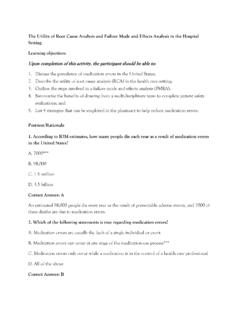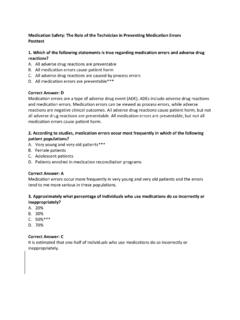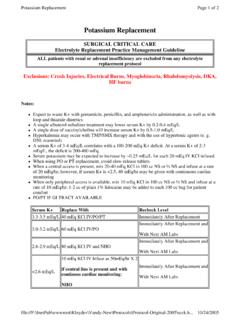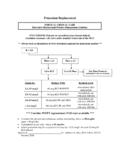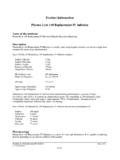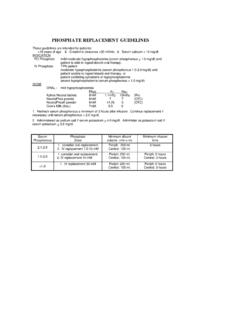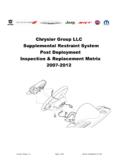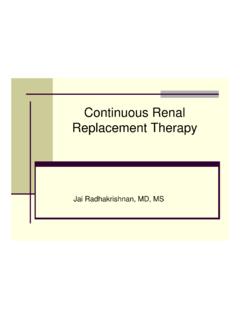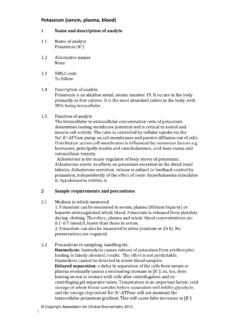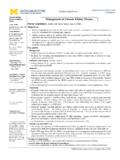Transcription of Dehydration: New Approaches to an Age -Old …
1 dehydration : New Approaches to an Age-Old problem learning objectives Upon completion of this activity, the participant will be able to: 1. Assess patients presenting with potential signs and symptoms of dehydration ; 2. Describe possible etiologies of dehydration and give examples of patients who might be at high risk for dehydration ; 3. Discuss the pathophysiologic consequences of dehydration and related fluid and electrolyte imbalances; 4. Describe the need for oral replacement therapy (ORT) solutions for restoring normal physiology and the use of ORT solutions for preventing and treating dehydration ; and 5. Formulate a plan for patients with or at high risk for dehydration that includes the use of over-the-counter products or a referral for medical care. Post-test/Rationale 1. Which of the following set of symptoms provides the best information in community and ambulatory pharmacy settings for assessing a patient s hydration status? A. Rapid breathing, dizziness or sleepiness, and weight loss B.
2 Sensation of thirst, urine output, and weight loss** C. Changes in skin color, urine output, and weight loss D. All of the above Correct answer: B The triad of symptoms that patients and health professionals can use to assess hydration status is thirst, urine output and color, and decreases in body weight associated with a process in which water and electrolytes could be lost. Option B presents this triad the WUT mnemonic as depicted in Figure 1 of the article. 2. Which of the following pairs correctly matches a component of balanced oral replacement therapy with its rationale for use? A. Glucose/dextrose: drives active transport of electrolytes in the intestines** B. Sucrose: produces energy C. Sodium: decreases sodium reabsorption in the intestines D. Chloride: produces acid (H+) Correct answer: A Glucose is included in oral replacement therapy (ORT) products to enhance the activity of the intestinal sodium potassium-activated ATPase pump; dextrose is an isomer of glucose.
3 Sucrose needs to be broken down into its components, glucose and fructose, before it can be used for energy production. Sodium is included in ORT products so that more sodium, not less, can enter general circulation. Acid-base balance is not affected by chloride content; other salts and buffers are needed if acid base balance is a factor in dehydration . 3. You are a pharmacist at a community pharmacy. A mother presents with her 15-month-old daughter who has had 12 loose bowel movements over the past 2 days. Upon questioning, the mother says that the girl s weight has dropped from approximately 22 pounds (10 kg) to 21 pounds ( kg). The child is on a diet of solid foods and whole milk, is having 2 or 3 wet diapers each day, and has not traveled outside the immediate area in recent weeks. What advice would be best for you provide? A. Take the girl to her pediatrician within 24 hours B. Use a balanced oral replacement therapy product until the girl regains the lost weight while continuing her normal diet as tolerated and monitoring for any further weight loss** C.
4 Take the girl to an emergency department immediately D. Continue the girl s normal diet as tolerated and seek medical care if the girl s weight declines to 20 pounds (9 kg) Correct answer: B According to the signs and symptoms of dehydration listed in Table 1, the girl has a moderate fluid deficit, and this can generally be treated with commercially available or over-the-counter products. The history provided by the mother indicates that the type of dehydration is likely isotonic. This should be treated with oral replacement therapy to reverse the loss quickly and then a normal diet should be used to maintain fluids and electrolytes in the normal range. 4. Changes in the World Health Organization s formula for oral rehydration salts in 2003 and 2006 made the resulting solution: A. Hypertonic B. Higher in potassium C. Hypotonic** D. Lower in potassium Correct answer: C The total osmolarity of solutions made using the new formula is 245 mOsm/L, which is hypotonic relative to normal human plasma osmolality of 280 to 295 mOsm/kg.
5 The previous solution was slightly hypertonic ( 310 mOsm/L). The potassium content remained the same at g/L. 5. When assessing hydration status in patients with vomiting, the presence of which of the following conditions would prompt the pharmacist to make a referral for medical care? A. Pregnancy** B. Diabetes C. Hypertension D. All of the above Correct answer: A Pregnant women with emesis should be monitored by their obstetricians. Vomiting in patients with most other conditions and comorbidities can use home care or over-the-counter treatments unless severe dehydration occurs, a bacterial pathogen may be the cause, or acid base imbalance develops. 6. Oral rehydration salts were originally developed for treating which of the following conditions? A. Vomiting from rotavirus infections B. Diarrhea from rotavirus infections C. Vomiting from cholera D. Diarrhea from cholera** Correct answer: D Cholera produces diarrhea so severe that patients can go from initial symptoms to death in as little as 12 hours.
6 The development of oral rehydration salts for prompt treatment had such a profound effect on cholera outbreaks that it is considered one of the most important medical discoveries of the 20th century. 7. Sports drinks should be avoided in young children and adolescents engaged in recreational sports of limited duration and intensity because: A. Their use is associated with osmotic diarrhea B. They lack sufficient glucose to promote sodium absorption C. They contain excess calories and thus contribute to overweight/obesity** D. Their use is associated with hyperkalemia Correct answer: C The American Academy of Pediatrics advises against the use of sports drinks in most children s recreational sports because the large carbohydrate contents of the drinks can lead to unrecognized and unnecessary increases in caloric intake. In addition, since sports drinks are not generally consumed as part of a normal diet, the high carbohydrate load is not balanced by protein, fat, and other nutrients.
7 8. Which of the following is the best advice for patients who want to use herbal teas for treating moderate dehydration ? A. Teas are good choices for this situation B. A glucose product should be used to sweeten teas when they are used for treating dehydration C. Teas are adequate therapies only if consumed in large volumes D. Culturally appropriate teas in small amounts are acceptable as long as used with balanced oral replacement therapy products** Correct answer: D Teas contain virtually none of the ingredients needed for treating dehydration . However, if patients cultural beliefs call for their use, they can be combined with proven therapies such as balanced oral hydration therapy products. Caffeinated teas should only be used in small volumes to avoid a diuretic effect that could increase electrolyte loss. 9. Severe emesis (vomiting) may require medical attention because of potential: A. Alkalosis** B. Acidosis C. Both of the above D. None of the above Correct answer: A The loss of large volumes of acidic gastric fluid can deplete the body of acid and lead to metabolic alkalosis.
8 10. You are a technician at a community pharmacy. A 70-year-old man presents to the pharmacy and requests recommendations for preventing dehydration during an upcoming international flight from the United States to Singapore (23 hours flying time plus connection time). The patient is taking medications for hypertension, including a potassium-sparing diuretic and an angiotensin-converting enzyme inhibitor, and nonsteroidal anti-inflammatory drugs. What can you tell the patient before you refer him to the pharmacist? A. Show him the selection of sports drinks and colas and tell him that any fluid can prevent dehydration and his selection should be made on the basis of personal preference B. Advise him that dehydration cannot be prevented and assure him that he only needs to be concerned about dehydration if he has signs and symptoms of a gastrointestinal infection when he is traveling C. Tell him that drinking bottled water on the plane should be sufficient for preventing dehydration D.
9 Show him the oral replacement products that can be taken through airport security and reconstituted using bottle water on the plane** Correct answer: D International air travelers can become dehydrated due to a variety of factors, including low humidity of cabin air that increases respiratory water loss, inadequate water intake, increased intake of diuresis-producing caffeine and alcohol, and altered sleep/wake cycles that affect dietary and fluid consumption. This patient is already on a diuretic and is taking medications that can produce renal injury, especially if dehydration occurs. Since electrolytes are lost with these processes, replenishment with water may be insufficient or, in extreme cases, could create hypotonic dehydration . Sports drinks and colas often do not have the appropriate balance of dietary needs, water, and electrolytes, and passengers should avoid diuresis-enhancing caffeine and alcohol products. The technician can explain the importance of maintaining a healthy diet while traveling and of preventing dehydration .
10 The pharmacist will be able to offer specific guidelines for choosing balanced oral replacement therapy products after reviewing the patient s medication history.
